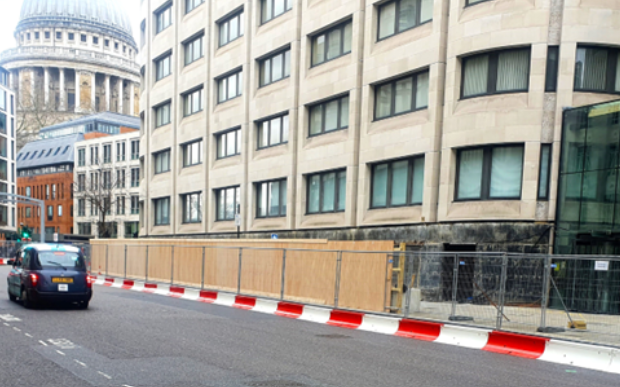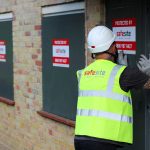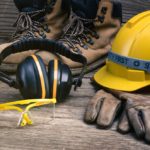Sponsored
A grounded approach to construction in windy weather
31 May 23

Building operations must be protected against the dangers of high winds, even at ground level, says UK construction site safety and security expert, SafeSite Facilities. The company says proper assessment of wind speeds, using wind-tested products, and training for workers is all essential for ensuring safety and productivity.
Buildings propel wind
Wind speeds can be affected by various factors such as building height, shape, and location. For instance, tall buildings can increase street-level wind speeds by creating a “wind tunnel” effect. This can pose a risk to pedestrians and construction workers on the ground.
The shape and design of a building can also affect wind speeds. Buildings with sharp edges or protruding features can cause turbulence, increasing wind speeds and making it more difficult to work safely on the ground.
The construction site’s location can also play a role, as areas with more exposure to open spaces or high elevations can experience stronger winds. In all cases, it’s vital to assess the impact of these factors on construction sites and take necessary precautions to protect workers and prevent damage to the site.
Wind-tested solutions
There are products out there specifically designed to withstand strong winds on construction sites, including wind-tested barriers, fencing, and sheeting.
For example, the Bison 800 Barrier here is a fantastic solution for construction sites and is a wind-tested option that’s perfect for demarcating where traffic and people can go and protecting personnel from accidental impact. Due to its water-filled design, it offers a solid and sturdy barrier that can resist wind better than traditional stand-alone panels.
Combined with mesh fencing or hoarding panels, the Bison 800 Barrier offers improved wind resistance and has achieved multiple Class A passes when tested to MIRA standards.
Heavy-duty, Anti-Climb fencing panels here are engineered to withstand high winds, made from a solid reinforced steel structure easily anchored securely to the ground. When the winds pick up, you can depend on this temporary fencing on construction sites in high-wind areas.
But operators will eventually want to erect permanent hoarding, mainly when construction is destined to continue for months. Dug-in Timber hoarding here offers many benefits for construction sites, including increased privacy, enhanced security, and improved safety.
This option’s secure foundation ensures that the perimeter remains stable and upright in all types of weather, preventing unauthorised access and reducing the risk of vandalism. With a height of 2.4 metres, it presents a significant obstacle to climbers and is available in different thicknesses to ensure optimal durability in the face of high winds and storms.
For locations where barriers might need repositioning, Jersey Concrete Barriers is a robust, heavy-duty solution that interlocks to create a strong, durable protective barrier. They offer an exceptional level of security and protection while still allowing for easy access when necessary.
Jersey barriers are ideal for wind-exposed areas, allowing for traffic management, flood defence, site security, and perimeter protection, whatever the wind speed. With their ability to be easily removed and repositioned, they provide a flexible solution for diverse needs.
It pays to protect
The benefits of wind protection on construction sites really come down to improved safety, reduced downtime, and increased productivity.
Naturally, the foremost advantage is improved safety. These products are designed to withstand high winds, reducing the risk of damage and accidents caused by the wind. This, in turn, ensures that workers and visitors on the site are protected from potential hazards caused by strong winds.
By using wind-tested products, construction companies can maintain productivity levels, even in adverse weather conditions. The project can be completed on time or even ahead of schedule, increasing profitability.
Measuring makes sense
Site managers benefit from knowing the exact wind speed in order to deploy the right resources for protecting people and equipment.
Accurate assessments can help determine whether it is safe to continue with work on-site, and necessary precautions can be taken to mitigate any risks posed by high winds. Implementing site-specific wind management plans, securing loose objects, providing appropriate personal protective equipment, and working with trained and experienced installation teams can also provide additional protection against high winds.
Workers should be trained to work safely in windy conditions to mitigate risks and protect themselves from wind and flying debris. Regular training is necessary, with refresher courses provided, to ensure that workers are up-to-date with the latest safety practices and procedures.
By providing comprehensive training, employers can help ensure workers work safely in windy conditions, reducing the risk of construction site accidents, injuries, and downtime.
Take action for peace of mind
Adam at SafeSite Facilities comments: “Construction sites are vulnerable to the effects of strong winds, posing risks to workers, equipment, and materials. However, with the right wind-tested products and safety measures, construction sites can be better protected against wind hazards, ensuring the safety of workers and minimising the risk of project delays and damages.
“At SafeSite Facilities, we’ve spent years offering a wide range of wind-tested products that secure construction sites to protect all. We encourage all site managers to use these resources to proceed safely whatever the wind conditions.”
If you could use premium construction site protection solutions, get in touch with SafeSite Facilities today.






